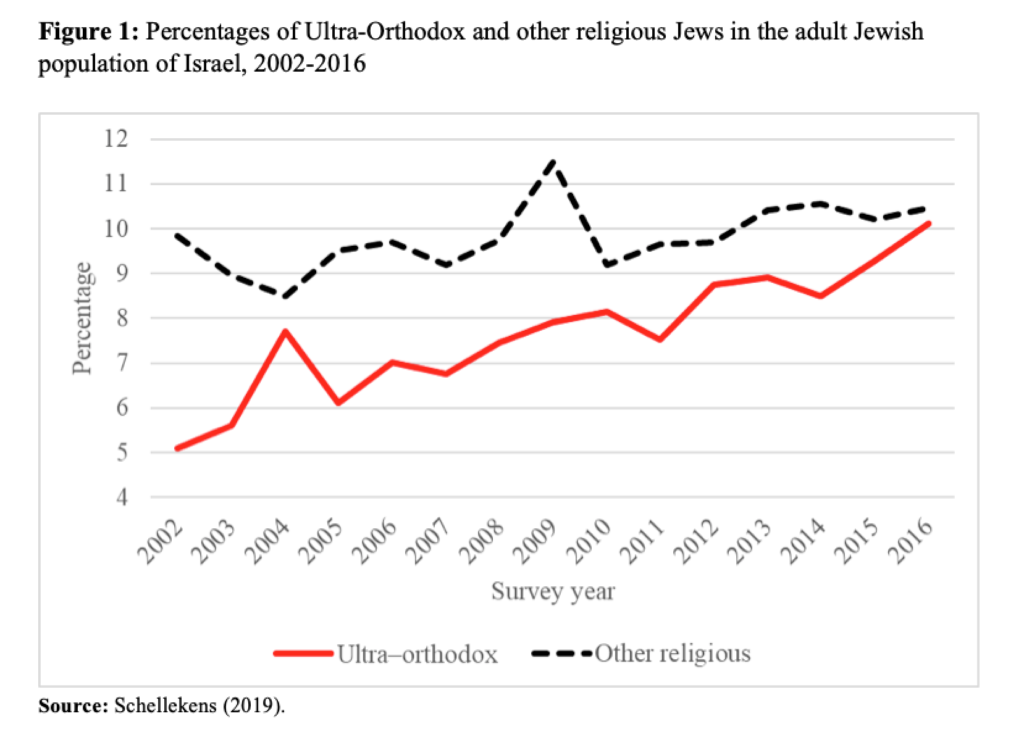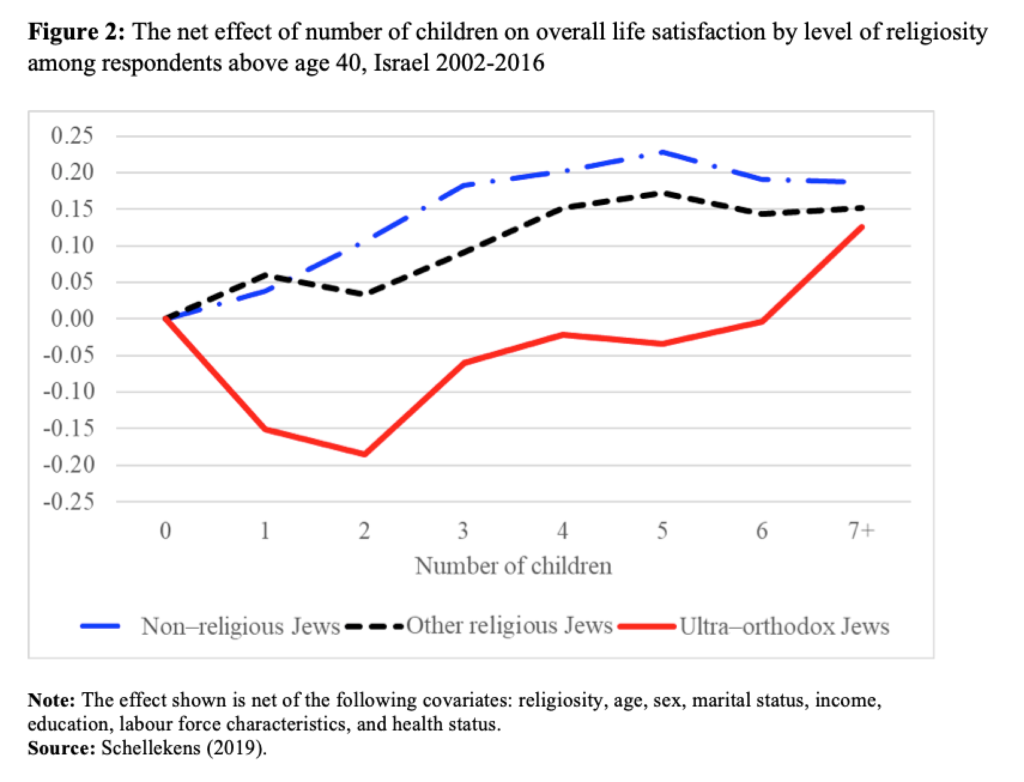Children, happiness and religiosity: the evidence from Israel

Religious couples tend to have more children than secular ones, suggesting that children add more to the happiness of the former than they do to the latter. Jona Schellekens investigated this hypothesis in Israel, showing that contrary to expectations, children do not contribute more to the happiness of religious Jews than they do to the happiness of secular Jews. Moreover, children contribute less to the happiness of Ultra-Orthodox Jews than they do to the happiness of other Jews.
Religiosity, fertility and happiness
Mounting evidence suggests that religious couples tend to have more children. When a religion tends to support pronatalist norms, children should add more to the happiness of religious couples than they do to the happiness of secular couples. This hypothesis fits data from the United States (Cranney 2017), but it is not known whether it also applies to ultra-religious groups, such as the Amish or Hutterites, who are very pronatalist. If the hypothesis is correct, children should contribute even more to the happiness of ultra-religious couples than they do to the happiness of other religious couples.
However, according to another hypothesis, children contribute less to the happiness of ultra-religious couples than they do to the happiness of secular couples. In ultra-religious groups, parenthood may increase social esteem. Couples with many children may gain considerable prestige from their fertility and may have higher status than less fertile couples. Thus, ultra-religious couples, whose family size falls short of the ideal family size in their reference group, may be less happy than secular couples with a similar number of children.
Unfortunately, the number of the ultra-religious in American surveys is too small to test these hypotheses.
Non-religious, religious and Ultra-Orthodox Jews
Compared to the United States and other OECD countries, the percentage of the ultra-religious in Israel is relatively high. Moreover, there are large differences in the number of children by level of religiosity. Ultra-Orthodox Jews, the Jewish equivalent of the Amish and Hutterites in the USA, have more than six children on average, followed by other religious Jews, mostly modern-orthodox, who have around four children. Secular Jews are at the lowest end of the range, with approximately two children (Okun 2017).
To study the relationship between children, happiness and religiosity, I used a pooled and integrated file of the Israel Social Survey for the years 2002-2016, which interviewed more than 100,000 respondents above age 20 (Schellekens 2019). The survey includes questions about the number of children, happiness and religiosity. Figure 1 presents an estimate of the percentages of Ultra-Orthodox and other religious Jews among the Jewish population of Israel in the survey for each year. It shows that the percentage of Ultra-Orthodox Jews has increased at a faster rate than that of other religious Jews. Today, each group constitutes about ten percent of the adult Jewish population.

The survey does not ask about happiness but about a related concept: overall life satisfaction. Respondents were asked: “Overall, how satisfied are you with your life?” and the four possible answers were: “very satisfied”; “satisfied”; “not so satisfied”; or “not satisfied at all”. In the statistical analysis, I used a very simple numerical scale, ranging between one for those who were not satisfied at all to four for those who reported being very satisfied.
Younger Ultra-Orthodox couples whose family size falls short of the ideal may feel social pressure to continue childbearing, but a small number of children is less likely to affect their overall life satisfaction because they still have a chance to make up for it. For older Ultra-Orthodox couples on the other hand, it is too late to close the gap between ideal and actual family size. Therefore, I will only present results for respondents who were above age 40, which reduces the sample size to about 58,000 respondents. There were few differences between the religious Jews who defined themselves as “traditional” or “secular”, so I combined these two categories.
The net contribution of children to life satisfaction by religious attachment
Figure 2 presents estimates of the net contribution of the number of children to overall life satisfaction by level of religiosity. One way to explain Figure 2, is to assume that there are two married women aged 50 with one child, one Ultra-Orthodox and the other non-religious, both of whom are employed, in good health, with average education and with average household income. The statistical model predicts that the overall life satisfaction of the Ultra-Orthodox woman will be 0.3 higher than that of the non-religious woman with the same characteristics. However, part of the difference is due to the fact that Ultra-Orthodox Jews tend to be more satisfied than non-religious Jews, other things being equal. Thus, to estimate the net contribution of one child, we need to subtract the contribution to overall life satisfaction of being Ultra-Orthodox. The result is –0.2 (=0.3–0.5). Thus, surprising as it may seem, the net contribution to life satisfaction of one child is 0.2 higher for non-religious than for Ultra-Orthodox Jews. Of course, we would obtain the same results if both women were 60 years old, unemployed, uneducated or in bad health. In a similar way, we find that the net contribution to life satisfaction of two children is 0.3 higher for non-religious than for Ultra-Orthodox Jews.

Figure 2 shows that after two children, the gap starts to close until only a small and insignificant difference remains among couples with at least seven children. It also shows that the differences between other religious Jews and non-religious Jews are much smaller. Thus, among Israeli Jews there is no evidence for the hypothesis that children add more to the overall life satisfaction of other religious couples than they do to the happiness of non-religious couples.
Of course, we do not know for sure why children contribute less to the overall life satisfaction of Ultra-Orthodox Jews than to that of other Jews. However, the hypothesis that high social status is attached to large families among Ultra-Orthodox Jews and that there is social pressure to conform to the ideal of large families is consistent with the data.
References
Cranney, S. (2017). Is there a stronger association between children and happiness among the religious? Religion as a moderator in the fertility/happiness relationship. Journal of Happiness Studies 18: 1713-1727.
Okun, B. S. (2017). Religiosity and fertility: Jews in Israel. European Journal of Population 33(4): 475-507.
Schellekens, Jona (2019). Does the association between children and happiness vary by level of religiosity? The evidence from Israel. Demographic Research 41(5):